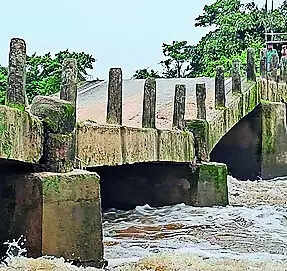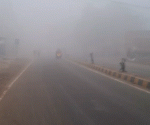Bridge Collapses in Kishanganj District | Patna News – Times of India

Patna: The bridge collapse spree continued in the state, with another structure on Kankai-Maria river in Digghalbank block of Kishanganj district collapsing on Wednesday night — fourth in the last 10 days.
Four big or small bridges have collapsed since June 18, starting with the still-to-be inaugurated bridge on Bakra river in Sikti block of Araria district.
It was followed by the collapse of a 35-year-old bridge on Gandak canal in Siwan district on June 22. A day later, a bridge being constructed for Rs 1.5 crore on a canal in Ghorasahan block of East Champaran district collapsed.
Finally on Wednesday night, the 70-metre-long and 12-metre-wide bridge in Kishanganj district collapsed. With the Kankai-Maria river in full spate, a pillar of the bridge tilted, as a result the deck on it sunk. No one was injured in the bridge collapse, even as traffic movement continued on Thursday morning before personnel from Digghalbank and Bahadurganj police stations reached the spot and erected barricades on both sides. Kishanganj district magistrate Tushar Singla, accompanied by deputy superintendent of police Abhinav Parashar, took stock of the situation.
Once the administrative vigil eased, the local residents, however, started crossing the bridge on foot, risking their lives, to avoid a 10-km circuitous route. “It seems our spine has been broken. Our farmland is only 200 metres away on the other side of the bridge. Now, we will have to take a 10-km circuitous route to reach our farm. Those having shops there will also have to do the same,” Digghalbank panchayat samiti member Manjar Alam told media persons.
The bridge had been constructed in 2011 with an investment of Rs 25 lakh as part of Pradhan Mantri Gram Sadak Yojana. It linked Digghalbank, Bahadurganj and Thakurganj blocks, besides 327E National Highway. Local resident Mohammad Arif blamed the collapse on rain occurring in the catchment areas of the river in Nepal for the last three days. The pillar tilted due to the rush of water, he said.
All these incidents were followed by the usual reaction of the officials, saying “the matter will be investigated and the guilty punished”. In Araria, two engineers were suspended soon after the incident.
A similar observation was made by rural works department (RWD) additional chief secretary Dipak Kumar Singh in response to the collapse of the 16-metre long bridge in East Champaran district on June 23. The work entailed an expenditure of Rs 1.5 crore.
As the exact cause of the incident was not yet known, Singh told a section of the media that a departmental inquiry has been ordered and action would be taken against the guilty.
However, views from a cross section of the local residents suggest that the real causes are four-fold: alleged lax monitoring of the construction work, oral assurance given by the executing agency that the work was being done properly, use of sub-standard materials and the agency’s tendency to cut the expenditure on materials and their transportation to maximise profits.
In Araria district, it was quite apparent that sub-standard materials were used when the local residents scrapped the pillars of the collapsed bridge with their fingers. They found that amorphous sand and concrete were falling apart, like dust from the surface of ant-hills. Three of the 16 pillars of the Sikti bridge constructed at an overall cost of Rs 12 crore had collapsed. The bridge was awaiting construction of two approach roads before its inauguration.
Four big or small bridges have collapsed since June 18, starting with the still-to-be inaugurated bridge on Bakra river in Sikti block of Araria district.
It was followed by the collapse of a 35-year-old bridge on Gandak canal in Siwan district on June 22. A day later, a bridge being constructed for Rs 1.5 crore on a canal in Ghorasahan block of East Champaran district collapsed.
Finally on Wednesday night, the 70-metre-long and 12-metre-wide bridge in Kishanganj district collapsed. With the Kankai-Maria river in full spate, a pillar of the bridge tilted, as a result the deck on it sunk. No one was injured in the bridge collapse, even as traffic movement continued on Thursday morning before personnel from Digghalbank and Bahadurganj police stations reached the spot and erected barricades on both sides. Kishanganj district magistrate Tushar Singla, accompanied by deputy superintendent of police Abhinav Parashar, took stock of the situation.
Once the administrative vigil eased, the local residents, however, started crossing the bridge on foot, risking their lives, to avoid a 10-km circuitous route. “It seems our spine has been broken. Our farmland is only 200 metres away on the other side of the bridge. Now, we will have to take a 10-km circuitous route to reach our farm. Those having shops there will also have to do the same,” Digghalbank panchayat samiti member Manjar Alam told media persons.
The bridge had been constructed in 2011 with an investment of Rs 25 lakh as part of Pradhan Mantri Gram Sadak Yojana. It linked Digghalbank, Bahadurganj and Thakurganj blocks, besides 327E National Highway. Local resident Mohammad Arif blamed the collapse on rain occurring in the catchment areas of the river in Nepal for the last three days. The pillar tilted due to the rush of water, he said.
All these incidents were followed by the usual reaction of the officials, saying “the matter will be investigated and the guilty punished”. In Araria, two engineers were suspended soon after the incident.
A similar observation was made by rural works department (RWD) additional chief secretary Dipak Kumar Singh in response to the collapse of the 16-metre long bridge in East Champaran district on June 23. The work entailed an expenditure of Rs 1.5 crore.
As the exact cause of the incident was not yet known, Singh told a section of the media that a departmental inquiry has been ordered and action would be taken against the guilty.
However, views from a cross section of the local residents suggest that the real causes are four-fold: alleged lax monitoring of the construction work, oral assurance given by the executing agency that the work was being done properly, use of sub-standard materials and the agency’s tendency to cut the expenditure on materials and their transportation to maximise profits.
In Araria district, it was quite apparent that sub-standard materials were used when the local residents scrapped the pillars of the collapsed bridge with their fingers. They found that amorphous sand and concrete were falling apart, like dust from the surface of ant-hills. Three of the 16 pillars of the Sikti bridge constructed at an overall cost of Rs 12 crore had collapsed. The bridge was awaiting construction of two approach roads before its inauguration.
















